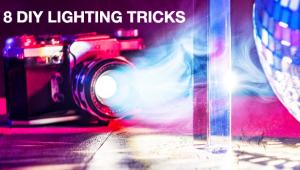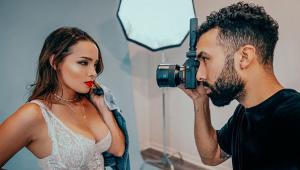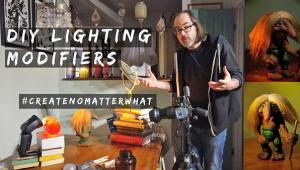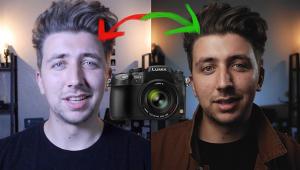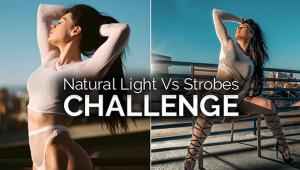Light Touch: Joe McNally On How to Use Multiple Speedlights to Capture Eye-Popping Portraits

Shooting in yet another Peruvian setting, McNally noted, “This is where Speedlights are ridiculously handy. Her main light, to camera right, is an SB-910 aimed through an Ezybox and hoisted up on a paint pole. Two other Speedlights, with warm gels to simulate the setting sun, were held by assistants and added color to her shoulders and illuminated the breaking wave. The tricky part was waiting for a big wave to hit the rocks. We got pretty wet shooting this.”
All Photos © Joe McNally
Joe McNally learned the value of supplementing available light with flash early on in his career as a photojournalist. Currently a Nikon Ambassador who works mainly as a commercial/editorial portrait photographer, McNally has become a staunch advocate for the use of Nikon Speedlights on location, often using these small flashes off camera in multiple lighting setups. McNally even mixes his Speedlights with studio strobes on occasion when the situation warrants.
In our interview with McNally, we ask him about his lighting techniques and how photographers can capture striking portraits using small strobe flashes in a variety of setups.
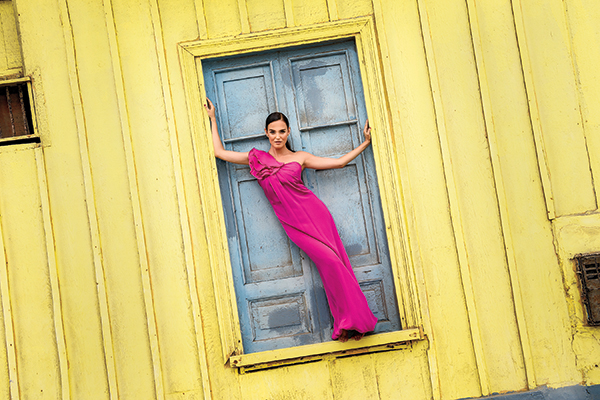
The sky was overcast as McNally found a compelling setting for this lovely Peruvian model. “I used an extendible paint pole (bought at a hardware store) on which to mount my lights, in this instance a Triflash fitted with three SB-910s through a shoot-through umbrella. The purpose of this rig was to brighten her face a little bit and emphasize the color of her gown.” An assistant held the paint pole.
Why Use Flash?
Shutterbug: What motivated you to use flash on a regular basis?
Joe McNally: I was always curious about light and was always motivated to shoot the lowest possible ISO I could for quality purposes. When I started and was just learning the ropes, I would occasionally shoot with on-camera flash but didn’t like the look of it. So I started to experiment with off-camera flash. My real motivation came when I’d secured a position as staff photographer in 1979 with ABC television in New York. My boss at ABC informed me that “we shoot Kodachrome. And we light things.” And he expected me to get onboard, so I had to do on-the-job training very, very quickly.
SB: What Nikon Speedlight accessories do you normally use?
JM: The diffusion dome that comes with the Speedlight is something I use a great deal. Speedlights are small light sources, so whatever you can do to broaden the light output is a good thing. I leave my dome diffusers on even when I put my Speedlights into a softbox or an umbrella.
SB: You mentioned umbrellas and softboxes. Do you use those extensively with your Speedlights?
JM: I use them all over the place. The heart and soul of Speedlights is their versatility and portability, so I’m indoors, outdoors with them all the time. Speedlights can be used in the studio, but they really thrive out on location. You take them whenever and wherever you go. I’ve always been a big fan of taking the principles of the studio and bringing them out into the world.
SB: When you employ umbrellas, do you use bounce or shoot-through?
JM: I tend to prefer shoot-through. I like the directionality of this form of light, in the sense that it’s not scattered all over the place. You can get more of a luminous feel with a shoot-through because you can get the actual light-shaper surface closer to the subject. Again, it depends on the nature of the subject. With one person, I generally use a shoot-through. If I have a big group, I’ll opt for a bounce umbrella, because the light tends to scatter over a larger area.

Shooting on a semi-deserted street at night in Lima, Peru, McNally essentially crafted a beauty light with two Lastolite Ezyboxes—one high and one low—for the model. The warm tone on her back is coming from the streetlights. Technical info: ISO 400, f/2.8, 1/30 second.
McNally on Wireless Flash
SB: I switched to Nikon because of Nikon’s Creative Lighting System (CLS) and built-in support for wireless TTL flash control, which originally employed a line-of-sight optical pulse to trigger remote units. How vital has Nikon CLS and wireless TTL control been to your shooting style, before the SB-5000 was introduced?
JM: It’s been a very important part of my workflow for many years. When I go on a job, I have several Speedlights with me. My Speedlights are an incredibly important component of what I take with me as a basic kit.
SB: How has the new Nikon SB-5000 with built-in radio remote triggering changed your shooting style?
JM: It’s a huge development. It frees you from line of sight. Now the next step has been taken, which allows you to extend your reach, extend your imagination, enlarge the envelope of what might be possible. With the SB-5000 triggered by radio remote, lights can now be hidden. You can put the SB-5000 directly behind the subject and still trigger it wirelessly.
The wonderful thing about the SB-5000 and this new system is that it’s fully integrated with your 910s, 900s, etc. I just did a major shoot where I used both radio-TTL and line-of-sight simultaneously. And they worked perfectly together. So it’s not like you have to leave your old flashes behind.

This portrait of blues performer Leo “Bud” Welch was shot in a downtown New York City club. “We took a break during the shooting session and I noticed him sitting there, looking very regal and very collected, with the chairs arranged in exactly this way. And I immediately knew I wanted to shoot it without changing a thing. Equally appealing, the dominant red color scheme throughout the shot.” McNally worked to augment the little bit of natural light coming in from camera left by adding a Lastolite 3x6-foot diffuser panel, popping three flashes through it. The red glow, in keeping with the dominant reds, came from a raw Speedlight (zoomed to 200mm to narrow the beam) with a red gel. Technical info: Nikon D810, 35mm f/1.4; ISO 250, f/6.3, 1/13 second.
Creating Multiple Lighting Setups
SB: How many Speedlights would you normally use on an assignment?
JM: It varies. On an average job, I’ll go out the door with four to six Speedlights. We have Think Tank Photo cases, with one kitted out as our Speedlight case. That will hold 10 Speedlights. So we know if we’re suddenly going out the door that we can just walk into the garage, pull that case off the shelf, and we’re ready to go with a complete lighting kit. We don’t have to open it up; we know everything we need is in there.
There is a place in every photographer’s life for big flash and small flash. And it’s entirely a judgment call on the part of each photographer when you cross that boundary. The beautiful thing about having the Nikon system is that, dating back to the SB-26 right up to now, you have built-in slaves. So if you need to migrate your small flash into a large flash scenario, you can just switch them over to what Nikon has referred to as SU-4 mode, or manual slave operation. The Speedlights will trigger very handily off a big light system if that becomes your situation on location. Versatility for any location photographer is a huge question. And I’m always mixing Speedlights with studio strobes.

Shooting at midday, under a blazing Peruvian sun, is rarely flattering to a beautiful young woman, in this scene artist Estefanía Cox, so Joe McNally corrected the situation by draping a 12-foot silk overhead. “That made for a very nice light, but it was flat. So we used the Triflash and three SB-910 Speedlights to literally pop her with light, using a shoot-through umbrella, aimed at her from camera left.”
SB: If someone has three or four Speedlights available, where would you suggest those flashes be placed, serving what roles?
JM: There were many times when I was able to create an effective portrait with just one Speedlight. If you want to create a scenario with four Speedlights, it’s easy to characterize those. You have a main light, a fill light, a background light, and maybe a separator—an accent light.
As you go further into a lighting scenario, it depends on obviously the logistics of the location: Is my subject being cooperative? How much time do I have? How fast do I have to move? I call these extra lights “luxury items.”
You put up one main light, and it looks good. Well, do I have time to get a little more effusive in the treatment I’m giving this? Okay, so maybe I’ll bounce another light off the floor, or use it weakly through another light shaper as a fill and just amplify the space a little bit, redirecting the light as needed.
Okay, how am I doing? I’ve got enough time, so let’s light the background. The background in this scenario might need two lights. Or can I throw a light off the deep background and just accent light a little bit, using only one of these two lights?
And then I have one light left, and maybe the person has an interesting hairdo that needs to be highlighted or they’re wearing dark clothing that needs to be separated with that extra light. So you put a glimmer on a shoulder.
I try to make sure that I don’t use light in a frivolous way. When I put a light in the field, it’s got a job to do. I’m not just lighting for lighting’s sake. When I put a light out there, it’s because there’s a dead spot in the photograph or something needs a little more illumination or I want to change a color someplace in the background. Everything I do in the field, hopefully, has a logic and a rationale.
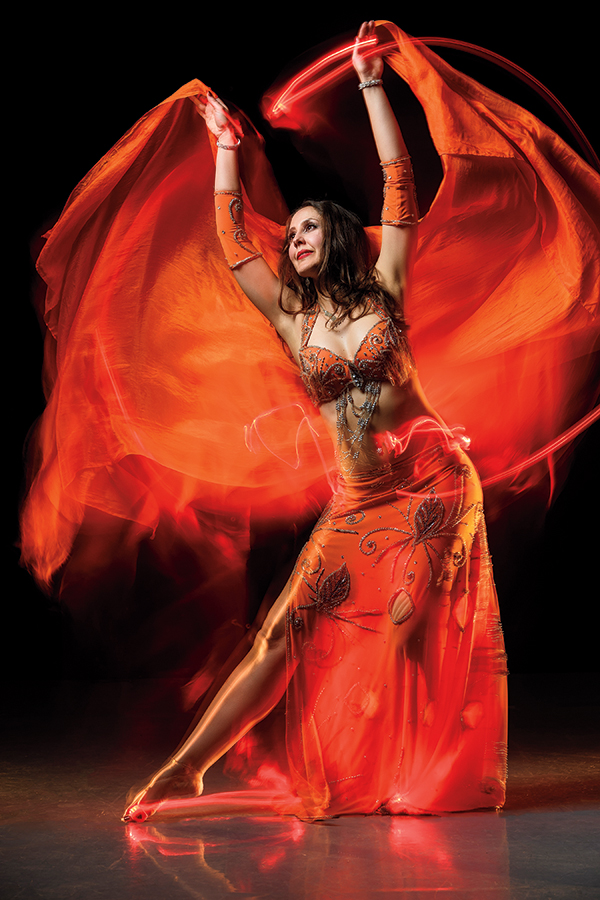
Shooting in a dance studio, McNally photographed belly dancer Cindy Marie Martin with a Nikon D5. The main lighting came from two Nikon SB-5000 Speedlights, positioned up at camera left and aimed through a large Lastolite Octa. To capture the trailing fabric as part of a two-second exposure while she was in motion, he added two hot lights on either side of her in the background, which also served to rim light her leg. One final touch…“She is wearing bicycle lights clipped to her toes, fingers, and waistband of her costume to enhance the effect.”
Out of Sight, But Not Out of Mind
SB: In this portrait scenario, when would you position an SB-5000 out of line of sight?
JM: Many times. For example, I have a situation tomorrow where I know I’m going to light someone on a fire escape over in New York City. I want to shoot it at dusk and I want that person to glow with a warm light, as if it’s coming through the window from inside the apartment. So I’ll be on the fire escape with my subject. I will not have line of sight with my Speedlights. So that’s where radio-TTL becomes a terrific blessing. I’m going to use one of the included Light Balancing filters to convert the daylight-balanced flash to incandescent balance, or close to it.

“Tough to say what is my absolute favorite. It is invariably the piece of gear I need to make the job work at that moment, so it can vary,” McNally explains. “I would say my favorite lens is the Nikon AF-S Nikkor 24-70mm f/2.8E ED VR lens. Now that it has VR, my ability to make sharp pictures at even slower shutter speeds is enhanced. It’s just a go-to lens, one I have with me on all shoots. Just an incredibly handy range of focal lengths, especially for a feature shooter such as myself.”
What’s in McNally’s Gear Bag
» Nikon D5 camera(s)
» Lexar XQD 128GB cards
» Nikkor lenses: 14-24mm f/2.8, 24-70mm f/2.8, 70-200mm f/2.8
» Two to six Nikon SB-5000 Speedlights
» Gitzo Series 2 Carbon 6X Explorer Tripod – 4 Section G-Lock
» Gitzo Series 3 Quick Release D GH3382QD Aluminum Center Ball Head, 5” Maximum Height
» Manfrotto 175F1 Spring Grip Clamps (Justin Clamps)
» Lastolite Joe McNally 4 in 1 Umbrella w/circular and square catchlight
» Lastolite Joe McNally 24” White Ezybox Hotshoe Softbox
» Lastolite Joe McNally Rotating Triflash
Joe McNally lives in Connecticut. To see more of his work and to learn about his workshops, visit joemcnally.com, or on Instagram: @joemcnallyphoto.



